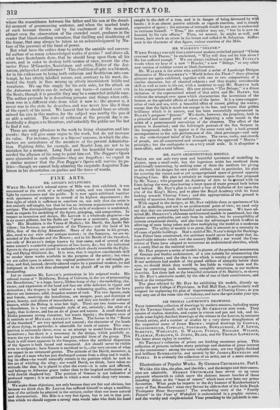FINE ARTS.
MR. LOUGH'S SCULPTURES.
WHEN Mr. Lotion's colossal statue of Milo was first exhibited, it was announced as the work of a self-taught artist, and was viewed in that light by connoisseurs and the public. It is now again exhibited, together with specimens of sculpture in several of its highest departments ; the first sight of which is sufficient to convince us, not only that the artist is not entirely self-taught, but that he has an intimate acquaintance with the antique. The distinguishing character of his style of sculpture is academical, both as regards his modelling of the figure, grouping, and composition. In respect to invention and design, Mr. LOUGH is a wholesale plagiarist—he is no covert pilferer, but his theft's are.'" gross as a mountain, open, palpa- ble." His Musidora is the Veims di M.edicis ; his David, the Apollo Bel- videre; his Somnus, an adaptathin of the Theseus ; and the head of his Milo, that of the dying Alexander. Many of the figures in his groups, also, recal to our view other antique statues : in the Sampson, e are re- minded of the Hercules and the Boxers ; and in his Battle of die Standard, not only of Rua Esrs's design known by that name, and of several of the same master's wonderful compositions of lion-hunts, &c., but the individual figures in the group are placed in attitudes which closely resemble the Fight- ing and Dying Gladiator, &c. It is true, that it requires considerable skill to render these works available to the purposes of the artist ; but when we are called upon to admire the original productions of a self-taught ge- nius, and find, instead, cleverly-altered copies by a practised student, we feel indignant at the trick thus attempted to be played off on the public un- derstanding. Let us examine Mr. Lotion's pretensions in his original works. His colossal statue of " Middleton, Bishop of Calcutta, in the act of pronouncing the Benediction," is a huge, heavy, lifeless lump of clay : the modelling, cha- racter, and expression of the head and face are alike deficient in vigour and animation ; the drapery is bad without a redeeming quality, and the lawn sleeves are immense, solid, shapeless masses of rock. The two figures, male and female, receiving the benediction, are meagre, poor, and destitute of grace, beauty, and almost of musculation ; and they are besides of ordinary stature, while the Bishop is nine feet high. There are two busts—one of a Gentleman, in a very self-taught style of art, certainly ; the other of a Lady, that is clever, and has an air of grace and nature. A small sketch of Elisha possesses strong character, but wants dignity ; the drapery even of it reminds us of MICHAEL ANGELO'S Moses. The horses in the " Battle of the Standard " are very spirited and natural ; the character of the heads of those dying, in particular, is admirable for truth of nature. This com- position is extremely clever, even as an attempt to model from RUMENS'S inventions ; but there is a monotony in the design, which painfully at- tracts the eye to the circular base and pyramidal form of the group. This fault is still more apparent in the Sampson, where the artificial disposition of the figures is both forced and unnatural. Art should never be visible even in sculpture ; here Nature is sacrificed to it,—the very reverse of what • we expect in an untutored genius. The attitude of the David, moreover, is not that of a man who has just discharged a stone from a sling and is watch- ing its effect—he would naturally remain in the position which he took in . the act of whirling the sling ; nor would David, we think, have taken an attitude like that he is placed in after the event—it is calm and affected, and belongs to Athenian grace rather than to the inspired enthusiasm of a wild Jewish shepherd boy. The position of Somnus is not indicative of profound repose; it is an attitude in which a man would sleep very uncom- fortably. We make these objections, not only because they are fair and obvious, but because we think that Mr. LOUGH has suffered himself to adopt a modifica- tion of the attitude he admired in the antique, rather than one more natural and characteristic. His Milo is a very fine figure, but is not in that posi- tion which we should suppose a strong man would take who finds his hand caught in the cleft of a tree, and is in danger of being devoured by wild beasts : it is an almost passive attitude as regards exertion, and is simply expressive of agony : the extreme of strength would be put out to endeavour to extricate himself. " True," the sculptor may say, " but he is now ex- hausted by his vain efforts." Then, we answer, he might as well, and better, have stuck an arrow in his breast and called it St. Sebastian. Suffer- ance is the character of that figure, violent exertion of the Milo.


















 Previous page
Previous page